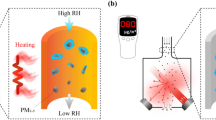Abstract
Lack of daily data on airborne particles has been a common problem in an air pollution research. To deal with this problem, a regression model was developed to estimate daily PM10 concentration using visibility in Bangkok from 1992 to 1997, based on 1092 visibility/PM10 pair-observations on low humidity days (humidity≤76.5%). Visibility was significantly and inversely associated with PM10 (r=0.71), after adjusting for minimum temperature and winter indicator variable. The R2 of the model was 0.51.
This is a preview of subscription content, access via your institution
Access options
Subscribe to this journal
Receive 6 print issues and online access
$259.00 per year
only $43.17 per issue
Buy this article
- Purchase on Springer Link
- Instant access to full article PDF
Prices may be subject to local taxes which are calculated during checkout


Similar content being viewed by others
Abbreviations
- PM2.5:
-
fine particulates less than 2.5 μm in aerodynamic diameter
- PM10:
-
fine particulates less than 10 μm in aerodynamic diameter
- TSP:
-
total suspended particle
- μg/m3:
-
micrograms per cubic meter
- μm:
-
microns
References
Abbey DE Ostro BE Fraser G Vancuren T and Burchette RJ, Estimating fine particulates less than 2.5 microns in aerodynamic diameter (PM2.5) from airport visibility data in California. J Exposure Anal Environ Epidemiol (1995a) 5: 161–180
Abbey DE Ostro BE and Peterson F, Chronic respiratory symptoms associated with estimated long-term ambient concentrations of fine particulates less than 2.5 microns in aerodynamic diameter (PM2.5) and other air pollutants. J Expo Anal Environ Epidemiol (1995b) 5: 137–159
Horvath H, Remarks and suggestions on nomenclature and symbols in atmospheric optics. Atmos Environ (1994) 28: 757–759
Kinney PL and Ozkaynak H, Association of daily mortality and air pollution in Los Angeles county. Environ Res (1991) 54: 99–120
Malm WC, Theory of radiation transfer and visibility. In: P.M. Irving (Eds.), Acidic Deposition: State of Science and Technology. Vol III Terrestrial, Materials, Health and Visibility Effects. The US National Acid Precipitation Assessment Program 1991 pp. 25–41
Nilsson BA, Model of the relation between aerosol extinction and meteorological parameters. Atmos Environ (1994) 28: 815–825
Ozkaynak H Schatz AD and Thurston GD, Relationship between aerosol extinction coefficients derived from airport visual range observations and alternative measures of airborne particle mass. JAPCA (1985) 35: 1176–1185
Pitchford W, Existing conditions and historical trendsIn: P.M. Irving (Eds.), Acidic Deposition: State of Science and TechnologyVol III Terrestrial, Materials, Health and Visibility Effects. The US National Acid Precipitation Assessment Program 1991 pp. 45–50
Pope CA and Schwartz J, Time series for the analysis of pulmonary health data. Am J Respir Crit Care Med (1996) 154: s229–s233
Schwartz J, Particulate air pollution and daily mortality in Detroit. Environ Res (1991) 56: 204–213
Sisler JF and Malm WC, The relative importance of soluble aerosols to spatial and seasonal trends of impaired visibility in the United States. Atmos Environ (1994) 28: 851–862
Trijonis J, Development and application of methods for estimating inhalable and fine particle concentrations from routine hi-vol data. Atmos Environ (1983) 17: 999–1008
Tsai FC Smith KR Vichit-Vadakan N Ostro BD Chestnut LG and Kungskulniti N, Indoor/outdoor PM10 and PM2.5 in Bangkok, Thailand. J Exposure Anal Environ Epidemiol (2000) 10: 15–26
Acknowledgements
The views expressed in this article are those of the individual authors and do not necessarily reflect the views and policies of the Environmental Protection Agency (EPA). The research described in this article has been subject to EPA's peer and administrative review and it has been approved for publication.
Author information
Authors and Affiliations
Corresponding author
Rights and permissions
About this article
Cite this article
VAJANAPOOM, N., SHY, C., NEAS, L. et al. Estimation of particulate matter from visibility in Bangkok, Thailand. J Expo Sci Environ Epidemiol 11, 97–102 (2001). https://doi.org/10.1038/sj.jea.7500148
Received:
Accepted:
Published:
Issue Date:
DOI: https://doi.org/10.1038/sj.jea.7500148
Keywords
This article is cited by
-
Estimation of fine particulate matter in an arid area from visibility based on machine learning
Journal of Exposure Science & Environmental Epidemiology (2022)
-
Visibility, aerosol optical depth, and low-visibility events in Bangkok during the dry season and associated local weather and synoptic patterns
Environmental Monitoring and Assessment (2022)
-
The impact of short-term exposure to ambient air pollution on test scores in Iran
Population and Environment (2020)
-
A case-crossover analysis of the impact of weather on primary cases of Middle East respiratory syndrome
BMC Infectious Diseases (2019)
-
Effects of extreme temperatures on cerebrovascular mortality in Lisbon: a distributed lag non-linear model
International Journal of Biometeorology (2019)



